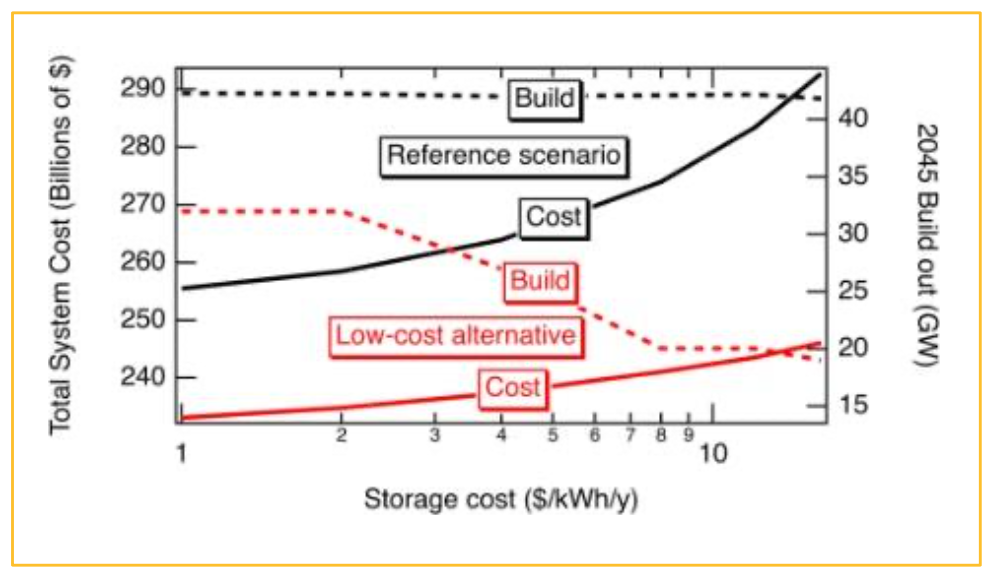QESST Researchers Model the Value of Storage in Reaching 100% Renewable Electricity
Outcome/Accomplishment
A new method for quantifying the value of storage towards reaching 100% renewable electricity has been made available by researchers with Quantum Energy and Sustainable Solar Technologies (QESST) – a National Science Foundation (NSF)-funded Engineering Research Center (ERC) based at Arizona State University (ASU) in partnership with the University of California, Merced.
Impact/Benefits
Storage is a flexible resource with the ability to perform many functions of grid support. Available optimization models help identify a pathway to lowest cost zero-carbon energy systems, but analysis can be complicated and there has not been a straightforward method for calculating the target cost and duration of storage needed for that storage to be a significant solution. Using a simplified energy system and analysis, QESST's work makes it possible to quantify both cost and duration targets for storage and explores the synergistic relationship between storage and solar energy in locations like California.
Explanation/Background
When modeling storage capacity expansion, current methodologies use many inputs and calculate many outputs. The method used by the QESST researchers dramatically simplifies analysis by varying the cost of the storage. The team plotted the optimized (minimum) cost to meet the modeled targets and the amount of storage built as a function of the input storage cost.
The team, which included Rhonda Bailey, Pedro Andres Sanchez Perez, Zabir Mahmud, and Sarah Kurtz, found that if the addition of storage is the only way to balance the grid, then the same amount of storage is built regardless. However, if there is an alternative way to balance the grid, then more storage is selected when the price is lower, allowing identification of the needed price for that storage to enter the market.
QESST's work was presented at the 47th IEEE Photovoltaic Specialists Conference (PVSC) in 2020; a research paper is available through IEEE at: https://ieeexplore.ieee.org/document/9300653
Location
Tempe, Arizonawebsite
Start Year
Energy and Sustainability
Energy, Sustainability, and Infrastructure
Lead Institution
Core Partners
Fact Sheet
Outcome/Accomplishment
A new method for quantifying the value of storage towards reaching 100% renewable electricity has been made available by researchers with Quantum Energy and Sustainable Solar Technologies (QESST) – a National Science Foundation (NSF)-funded Engineering Research Center (ERC) based at Arizona State University (ASU) in partnership with the University of California, Merced.
Location
Tempe, Arizonawebsite
Start Year
Energy and Sustainability
Energy, Sustainability, and Infrastructure
Lead Institution
Core Partners
Fact Sheet
Impact/benefits
Storage is a flexible resource with the ability to perform many functions of grid support. Available optimization models help identify a pathway to lowest cost zero-carbon energy systems, but analysis can be complicated and there has not been a straightforward method for calculating the target cost and duration of storage needed for that storage to be a significant solution. Using a simplified energy system and analysis, QESST's work makes it possible to quantify both cost and duration targets for storage and explores the synergistic relationship between storage and solar energy in locations like California.
Explanation/Background
When modeling storage capacity expansion, current methodologies use many inputs and calculate many outputs. The method used by the QESST researchers dramatically simplifies analysis by varying the cost of the storage. The team plotted the optimized (minimum) cost to meet the modeled targets and the amount of storage built as a function of the input storage cost.
The team, which included Rhonda Bailey, Pedro Andres Sanchez Perez, Zabir Mahmud, and Sarah Kurtz, found that if the addition of storage is the only way to balance the grid, then the same amount of storage is built regardless. However, if there is an alternative way to balance the grid, then more storage is selected when the price is lower, allowing identification of the needed price for that storage to enter the market.
QESST's work was presented at the 47th IEEE Photovoltaic Specialists Conference (PVSC) in 2020; a research paper is available through IEEE at: https://ieeexplore.ieee.org/document/9300653

